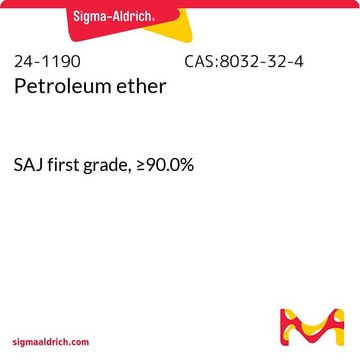28-2950
Sodium hydroxide
SAJ first grade, ≥95.0%
Synonym(s):
‘Caustic soda’
About This Item
Recommended Products
grade
SAJ first grade
vapor density
>1 (vs air)
vapor pressure
<18 mmHg ( 20 °C)
3 mmHg ( 37 °C)
Assay
≥95.0%
form
solid
availability
available only in Japan
mp
318 °C (lit.)
solubility
water: ~1260 g/L at 20 °C
density
2.13 g/cm3
SMILES string
[OH-].[Na+]
InChI
1S/Na.H2O/h;1H2/q+1;/p-1
InChI key
HEMHJVSKTPXQMS-UHFFFAOYSA-M
Looking for similar products? Visit Product Comparison Guide
Application
- MOF-Enhanced Aluminosilicate Ceramic Membranes Using Non-Firing Processes for Pesticide Filtration and Phytochrome Removal.: This research utilizes sodium hydroxide in the development of MOF-enhanced aluminosilicate ceramic membranes. These membranes are crafted through non-firing processes, highlighting their utility in filtering pesticides and removing phytochromes, offering substantial benefits for environmental management and agricultural applications (Zhao L et al., 2024).
- Assessing the Acidic and Alkaline Recalcitrance of Covalently Modified Surface Amines on Ordered Mesoporous Carbon.: The study examines the resistance of covalently modified surface amines on mesoporous carbon to acidic and alkaline environments, where sodium hydroxide is used to test alkaline recalcitrance. This work is pivotal for applications in catalysis and material science (Kovach NC et al., 2024).
- Formation of plasmonic core/shell nanorods through ammonia-mediated dissolution of silver(i)oxide for ammonia monitoring.: This article discusses the role of sodium hydroxide in synthesizing plasmonic core/shell nanorods. The process involves ammonia-mediated dissolution, which is critical for developing sensors for ammonia detection in environmental monitoring (Ghorbanian E et al., 2024).
- High temperature corrosion and oxide scale formation of nickel in molten NaOH at various basicity levels.: Investigates the corrosion behavior and oxide scale formation on nickel in molten sodium hydroxide. This study is crucial for understanding material degradation in high-basicity environments, which has implications for industrial processes involving caustic substances (Stoffersen B et al., 2024).
- Long-term durability of discarded cork-based composites obtained by geopolymerization.: Focuses on the durability of cork-based composites treated with sodium hydroxide and geopolymerized. This research is significant for waste management and recycling processes, providing insights into sustainable material usage (Poggetto GD et al., 2024).
Signal Word
Danger
Hazard Statements
Precautionary Statements
Hazard Classifications
Eye Dam. 1 - Met. Corr. 1 - Skin Corr. 1A
Storage Class Code
8B - Non-combustible corrosive hazardous materials
WGK
WGK 1
Flash Point(F)
Not applicable
Flash Point(C)
Not applicable
Regulatory Listings
Regulatory Listings are mainly provided for chemical products. Only limited information can be provided here for non-chemical products. No entry means none of the components are listed. It is the user’s obligation to ensure the safe and legal use of the product.
ISHL Indicated Name
Substances Subject to be Indicated Names
ISHL Notified Names
Substances Subject to be Notified Names
JAN Code
28-2950-8-20KG-J:
28-2950-5-500G-J:
28-2950-9-25KG-J:
Certificates of Analysis (COA)
Search for Certificates of Analysis (COA) by entering the products Lot/Batch Number. Lot and Batch Numbers can be found on a product’s label following the words ‘Lot’ or ‘Batch’.
Already Own This Product?
Find documentation for the products that you have recently purchased in the Document Library.
Customers Also Viewed
Our team of scientists has experience in all areas of research including Life Science, Material Science, Chemical Synthesis, Chromatography, Analytical and many others.
Contact Technical Service





